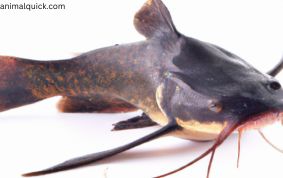Catfish is a type of freshwater fish recognized by its long, whisker-like barbels and flat head.
Let’s find out whether a catfish cat eats garri or not!
Can Catfish Eat Garri: No, catfish shouldn’t eat garri.
They need a fish-based diet, and garri, made from cassava, isn’t suitable or nutritious for them.
Can Catfish Eat Garri?
No, catfish cannot eat garri. Catfish are fish, and their diet consists of smaller fish, insects, and other aquatic creatures.
Garri is a human food made from cassava, and it is not suitable or nutritious for catfish.
If you have pet catfish, it’s important to feed them with proper fish food designed for their nutritional needs.
Is Chicken Garri Suitable for Catfish Nutritionally?
Chicken garri is not suitable for catfish in nutrients because of protein deficiency, lack of nutrients, and digestibility issues.
- Protein Deficiency: Catfish require high-quality protein for proper growth. Garri is primarily a carbohydrate source and lacks the necessary protein content.
- Lack of Essential Nutrients: Catfish need a variety of vitamins and minerals for various bodily functions. Garri does not offer a balanced profile of essential nutrients, potentially causing nutritional deficiencies in catfish.
- Imbalance of Nutrients: Even if used as a supplementary feed, garri may upset the nutrient balance in the catfish diet. The lack of essential nutrients, particularly protein, can negatively impact overall nutrition.
- Incomplete Amino Acid Profile: Proteins consist of amino acids, some of which are essential for catfish growth. Garri lacks certain essential amino acids required for optimal development.
- Digestibility Issues: While catfish are omnivores, not all foods are easily digestible for them. Garri may pose digestibility challenges, affecting nutrient absorption and utilization.
Benefits of Eating Chicken Garri for Catfish
The benefits of eating chicken gari for catfish are its provide energy source, dietary variety, and easy availability.
- Energy Source: Garri is rich in carbohydrates, serving as an energy source for catfish. While catfish primarily need protein for growth, carbohydrates can contribute to their overall energy needs.
- Dietary Variety: Introducing variety into the diet can be beneficial for catfish. While a complete catfish feed is ideal, occasional exposure to different foods may offer nutrient diversity and different flavors.
- Natural Foraging Behavior: Catfish are bottom-feeders, and if garri is present, they might forage on it, mimicking their natural behavior in the wild.
- Availability: In some environments, catfish might encounter garri, providing a supplemental food source.
How to Prepare Chicken Garri?
To prepare chicken garri for catfish, you need to collect ingredients such as chicken garri, fish meal, soybean meal, vegetable or fish oil, and vitamin and mineral supplements.
Ingredients:
- Chicken Garri: Purchase or prepare chicken garri from fermented cassava. Ensure it is free from contaminants and properly processed.
- Fish Meal: Supplement the chicken garri with fish meal to increase the protein content.
- Soybean Meal: Another protein-rich ingredient that can be added to improve the overall protein profile of the feed.
- Vegetable Oil or Fish Oil: To provide essential fatty acids.
- Vitamin and Mineral Supplements: To compensate for the lack of essential nutrients in chicken garri.
Instructions:
- Mixing Ratios: Begin with a base of chicken garri and add fish meal, soybean meal, and vegetable or fish oil. The ratios will depend on the nutrient content of the chicken garri and the nutritional requirements of catfish.
- Supplements: Add vitamin and mineral supplements to ensure that the feed is more nutritionally balanced.
- Grinding (Optional): Depending on the size of your catfish and the ingredients used, you may need to grind the feed to an appropriate particle size.
- Pelletizing (Optional): If you have the equipment, you can pelletize the feed for easier handling and feeding.
Can Catfish Live Only on Chicken Garri?
Catfish cannot live only on chicken garri as it lack the essential nutrients required for their growth, health, and overall well-being.
Chicken garri is primarily a carbohydrate-rich food made from fermented cassava and lacks the necessary proteins, fats, vitamins, and minerals that catfish need.
If catfish are fed only chicken garri, they may experience the following problems:
- Stunted Growth: Catfish require a substantial amount of protein for proper growth. Lack of sufficient protein in their diet can result in stunted growth and low body weight.
- Nutritional Deficiencies: Chicken garri does not provide a balanced profile of essential nutrients such as amino acids, vitamins, and minerals. Nutritional deficiencies can lead to weakened immune systems, skeletal deformities, and other health issues.
- Reproductive Issues: Inappropriate nutrition can affect the reproductive capabilities of catfish, leading to poor reproductive success and low survival rates of fry.
- Overall Health Decline: A diet lacking essential nutrients can compromise the overall health of catfish, making them more susceptible to diseases and stress.
Does Size and Age Affect Catfish Digesting Chicken Garri?
The size and age of catfish can influence their ability to digest different types of feed, including chicken garri.
Digestive capabilities in fish can vary with age due to changes in the digestive tract and enzyme production.
Here are some considerations:
Size
- Smaller Catfish: Smaller catfish may have more limited digestive capacities compared to larger ones. They often require smaller particle sizes and more easily digestible feeds.
- Larger Catfish: Larger catfish generally have a more developed digestive system and can handle a wider range of feed sizes and types.
Age
- Fingerlings and Juveniles: Young catfish, such as fingerlings and juveniles, may have more specific dietary requirements for growth. They often need diets with higher protein content to support rapid development.
- Adult Catfish: Adult catfish have different nutritional needs than juveniles. They may require less protein in their diet, and their digestive systems are adapted to handle a broader range of food sources.
Digestive System Development
The digestive system of catfish undergoes developmental changes as they grow.
Younger catfish may have a less developed digestive system, influencing their ability to efficiently digest certain feeds.
Particle Size
The size of feed particles can affect how well catfish can digest the feed.
Smaller particles may be more suitable for smaller catfish, while larger particles may be appropriate for larger individuals.
Nutrient Requirements
The nutrient requirements of catfish change with age.
Younger catfish may have higher protein requirements for growth, while adult catfish may require a more balanced diet to maintain health and reproductive capabilities.
Cost of Chicken Garri Compared to Other Foods
The cost of chicken garri compared to alternative feeds for catfish is relatively affordable.
However, its nutritional content may not be ideal for catfish, and using it as a primary feed could result in nutritional deficiencies.
When comparing the cost of chicken garri to alternative feeds for catfish, consider the following:
Commercial Catfish Feed
- Advantages: Commercial feeds are formulated to meet the specific nutritional needs of catfish at different growth stages. They typically contain a balanced mix of proteins, fats, vitamins, and minerals.
- Cost: Commercial feeds can be more expensive than raw ingredients like chicken garri, but they offer a nutritionally complete diet that supports optimal growth and health.
Soybean Meal and Fish Meal
- Advantages: Soybean meal and fish meal are protein-rich ingredients that can be used to supplement catfish diets. They provide essential amino acids crucial for growth.
- Cost: While soybean meal and fish meal may have a cost, they can be cost-effective protein sources when used in combination with other ingredients.
Homemade Feeds
- Advantages: Formulating homemade feeds using a combination of ingredients like grains, soybean meal, and fish meal allows for flexibility in adjusting nutrient content.
- Cost: The cost of homemade feeds depends on the prices of individual ingredients. It can be economical, especially if bulk purchasing is possible.
Availability and Local Prices
- Advantages: The availability of chicken garri or alternative ingredients may vary regionally. Local market prices can influence the overall cost of catfish feed.
- Cost: Depending on the local market, some ingredients may be more or less expensive than others.
Best Time to Feed Catfish
The best time to feed catfish depends on various factors such as water temperature, size and age of the catfish, and water quality.
- Water Temperature: Catfish are more active in warmer water, so, during warmer months, they may have a higher appetite.
- Morning and Evening: Feeding during cooler parts of the day, like early morning or late evening, is advisable, especially in hot climates. This helps prevent stress on the fish and reduces the risk of overfeeding.
- Consistent Schedule: Establishing a regular feeding schedule conditions catfish to expect food at specific times, promoting efficient feeding practices and better growth.
- Observation: Watch for the catfish’s behavior. If they actively seek and consume food, it’s a good time to feed. If they show little interest, it might not be the best time.
- Size and Age: Younger catfish generally grow faster and may need more frequent feeding. Adjust feeding based on the age and size of the catfish.
- Water Quality: Ensure the water quality is suitable for feeding. Poor water conditions can affect digestion and nutrient absorption. Avoid feeding during low oxygen levels or unfavorable water conditions.
How Many Months Catfish Takes to Grow?
A catfish grows in stages such as the fingerling stage, juvenile stage, sub-adult stage, and adult stage.
- Fingerling Stage: This is the early development stage, lasting a few weeks to months. Catfish are considered fingerlings when they’re just a few inches long.
- Juvenile Stage: Following the fingerling stage, catfish continue to grow noticeably. This stage can last several months, influenced by environmental conditions and available quality feed.
- Sub-Adult Stage: As catfish keep growing, they enter the sub-adult stage, lasting several months to a year or more, depending on the species and environment.
- Adult Stage: Catfish reach maturity at different ages, ranging from a year or two to longer periods. Once mature, their growth rate usually slows down.
Resources:
https://iopscience.iop.org/article/10.1088/1755-1315/1114/1/012016/meta
Read More:
- Can Catfish Grow Their Whiskers Back?
- Why Do Catfish Have Whiskers?
- Do Cory Catfish Produce a Lot of Waste?
- Do Catfish Poop?
- Are Catfish Bottom Feeders?
FAQs
Can catfish eat garri?
No, catfish cannot eat garri. Catfish are carnivorous fish and require a diet consisting of smaller fish, insects, and aquatic organisms. Garri is a human food made from cassava and does not provide the necessary nutrients for catfish.
Why is garri not suitable for catfish?
Garri is not suitable for catfish because it lacks the essential nutrients and proteins that catfish need for proper growth and health. Catfish are carnivores, and their diet should primarily consist of aquatic organisms, not human food products.
What should I feed my catfish instead of garri?
Provide your catfish with a balanced diet of commercially available catfish food. These formulated fish foods contain the necessary nutrients and proteins for the health and well-being of catfish.
Can feeding catfish garri harm them?
Yes, feeding catfish garri can potentially harm them because it does not meet their nutritional requirements. Catfish may suffer from nutritional deficiencies, stunted growth, or other health issues if not provided with a proper and balanced diet.
Are there any human foods that catfish can eat?
It is not advisable to feed catfish human foods. While some may consume small amounts of bread or fruits, relying on a proper catfish diet is crucial for their health. Always choose food specifically designed for catfish to ensure they receive the necessary nutrients.

I love animals & want to know more about different creatures & sharing their stories with everyone. From my childhood, I’ve been exploring forests & watching animals in their homes.
Now, I write about my adventures & all the amazing things I learned. My blogs are easy to understand & make you want to know more about animals. I teach about why animals are important & why we should take care of them.

